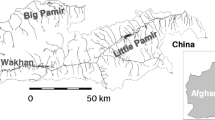Abstract
Pandanus is well represented in Papua New Guinea with over 66 species growing from sea level to 3,000 m. The territory of the Wopkaimin, who live at the headwaters of the Ok Tedi in the Star and Hindenburg Mountains, is particularly rich in wild and domesticated species ofPandanus. Detailed analysis of the species in classification, ecology, subsistence, ritual and material culture not only establishesPandanus as a locally significant plant resource but also contributes to the comparative understanding of ethnobiological systems. A close correspondence with botanical taxa of generic and specific rank and an absence of the most inclusive taxon term for plant are 2 cross-culturally important findings substantiated in WopkaiminPandanus taxonomy.
Similar content being viewed by others
Literature Cited
Barth, F. 1975. Ritual and Knowledge Among the Baktaman. Yale Univ. Press, New Haven.
Barrau, J. 1958. Subsistence Agriculture in Melanesia. Bishop Mus. Bull. 219, Honolulu.
Bowers, N. 1964. The Ascending Grassland: An Anthropological Study of Ecological Succession in a High Mountain Valley of New Guinea. Ph.D. diss. Columbia Univ., New York.
Berlin, B. 1978. Ethnobiological classification.In E. Rosch and B. Lloyd, ed, Cognition and Categorization. Erlbaum, New York.
—, D. E. Breedlove, and P. H. Raven. 1973. General principles of classification and nomenclature in folk biology. Amer. Anthropol. 75: 214–242.
Bulmer, R. 1974. Folk biology in the New Guinea highlands. Soc. Sci. Inform. 13: 9–28.
—. 1972–1973. Karam classification of marsupials and rodents. J. Polynes. Soc. 81:472–499, 82:86–107.
—, and F. Parker. 1975. Karam classification of reptiles and fishes. J. Polynes. Soc. 84: 267–308.
—, and M. Tyler. 1968. Karam classification of frogs. J. Polynes. Soc. 77: 333–385.
Clarke, W. 1971. Place and People: An Ecology of a New Guinea Community. Australian National Univ. Press, Canberra.
Diamond, J. 1966. Zoological classification system of a primitive people. Science 151:1102–1104.
Dornstreich, M. 1973. An Ecological Study of Gadio Enga (New Guinea) Subsistence. Ph.D. diss. Columbia Univ., New York.
Dwyer, P. 1976. An analysis of Rofaifo mammal taxonomy. Amer. Ethnol. 3:425–445.
Frodin, G., and D. Hyndman. 1982. Ethnobotany of the Ok Tedi drainage.In Ok Tedi Environmental Study, Working Paper 14. Maunsell & Partners, Melbourne.
Hays, T. 1979. Plant classification and nomenclature in Ndumba, Papua New Guinea highlands. Ethnology 18: 253–270.
—. 1980. Uses of wild plants in Ndumba, Eastern Highlands Province. Sci. New Guinea 7: 118–131.
—. 1981. Some cultivated plants in Ndumba, Eastern Highlands Province. Sci. New Guinea 8: 122–131.
—. 1983. Ndumba folkbiology and general principles of ethnobiological classification and nomenclature. Amer. Anthropol. 85: 592–611.
Hyndman, D. 1979. Wopkaimin Subsistence: Cultural Ecology in the New Guinea Highland Fringe. Ph.D. diss. Univ. Queensland, St. Lucia.
-. 1984. Hunting and the classification of game animals among the Wopkaimin. Oceania (in press).
—, and D. Frodin. 1980. Ethnobotany ofSchefflera in the Ok Tedi region, Papua New Guinea. Ethnomedizin 6: 101–126.
Lea, D. 1972. Indigenous horticulture in Melanesia.In R. Ward, ed, Man and Landscape in the Pacific Islands. Clarendon Press, Oxford.
MacLennan, R., M. Bradley, and R. Walsh. 1967. The blood group pattern at Oksapmin, Western Highlands, New Guinea. Archaeol. Phys. Anthropol. Oceania 2: 57–61.
Majnep, I., and R. Bulmer. 1977. Birds of My Kalam Country. Univ. Auckland Press, Auckland.
Norgan, N., J. Durnin, and A. Ferro-Luzzi. 1979. The composition of some New Guinea foods. Papua New Guinea Agric. J. 36: 25–40.
Ohtsuka, R. 1977. The saga eaters: an ecological discussion with special reference to the Oriomo Papuans.In J. Allen, J. Golson, and R. Jones, ed, Sunda and Sahul: Prehistoric Studies in Island Southeast Asia, Melanesia and Australia. Academic Press, London.
Panoff, F. 1972. Maenge Gardens: A Study of Maenge Relationship to Domesticates. Ph.D. diss. Australian National Univ., Canberra.
Powell, J. 1976. Ethnobotany.In K. Paijmans, ed, New Guinea Vegetation. Australian National Univ. Press, Canberra.
Rappaport, R. 1968. Pigs for the Ancestors. Yale Univ. Press, New Haven.
Rose, C. 1982. Preliminary observations on the pandanus nut (Pandanus jiulianettii Martelli).In R. Bourke and V. Kesavan, ed, Proceedings of the Second Papua New Guinea Food Crops Conference, Dept. Primary Industry, Port Moresby.
Sillitoe, P. 1983. Roots of the Earth: Crops in the Highlands of Papua New Guinea. Univ. Manchester Press, Manchester.
Sinclair, A. 1957. Field and Clinical Survey Report of the Mental Health of the Indigenes of the Territory of Papua New Guinea. W. S. Nicholas, Port Moresby.
Stone, B. 1976. The morphology and systematics of Pandanus today (Pandanaceae). Gard. Bull. 29: 137–142.
—. 1982. New Guinea Pandanaceae: first approach to ecology and biogeography.In J. Gressitt, ed, Biogeography and Ecology of New Guinea. Junk, The Hague.
Waddell, E. 1972. The Mound Builders. Univ. Washington Press, Seattle.
Author information
Authors and Affiliations
Rights and permissions
About this article
Cite this article
Hyndman, D.C. Ethnobotany of WopkaiminPandanus significant Papua New Guinea plant resource. Econ Bot 38, 287–303 (1984). https://doi.org/10.1007/BF02859007
Received:
Accepted:
Issue Date:
DOI: https://doi.org/10.1007/BF02859007




